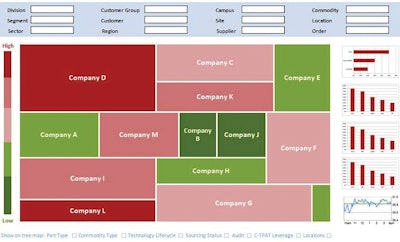
Effectively managing a supply chain, especially if it’s global, is a highly complex undertaking. Not only does a company have to concern itself with its own business goals—such as cost control and efficiency—it must also ensure customer satisfaction to provide timeliness, quality, consistency and service.
Enter the effective management of data to improve decision making—also otherwise known as Business Intelligence (BI).
BI tools play a crucial role in supply chain management, from forecasting to logistics and from inventory management to risk mitigation.
Global electronic manufacturing services companies—which design, test, manufacture and distribute a wide range of products including consumer electronics, medical devices and defense systems—face particularly daunting supply chain challenges. These include the sheer volume and diversity of components required; the tight deadlines associated with many products; the constant threat of counterfeit parts; and the impact of political economic and natural forces across the globe.
While most manufacturing services companies rely on off-the-shelf BI solutions, a strong argument can be made for building and implementing customized tools. In contrast to generic products that use standard assumptions and averages, proprietary BI tools can be designed specifically for a company’s unique needs and parameters, allowing planners and analysts to quickly change variables, pinpoint trends and drill down into details. Another benefit of proprietary technology is the opportunity to make it user-friendly to drive greater adoption, save valuable time and avoid knowledge silos.
The inclusion of actionable, measurable and proactive metrics—such as in Jabil’s BI tools—is one key differentiator amongst such technology. Predictive models identify productivity opportunities across various supply chain functions and proactively send automated alerts to the owners with a recommended action plan—along with quantification of improvement of the corresponding key performance indicators.
Best practices for custom BI tools
Following are a number of tips to identify the key benefits of custom BI tools.
1). Use business people, not IT people, as developers
Because these are business tools, they need to be developed by people who understand the needs and processes of commerce. Companies should find business people with the ability to program, instead of IT programmers required to learn the business. Although identifying these resources is difficult and takes time, the results are worth the effort. This approach helps to achieve simplicity and a focus on results, not on complex IT technologies for their own sake.
2). Work directly with users to understand their needs
Instead of isolating developers, have them sit with functional experts to understand the analytical processes used, such as how these experts search for and identify improvement opportunities. Developers can then design tool algorithms to automate these functions.
Use an “incubation” method: start small with a prototype. Try it out. Let users experiment and provide feedback. Based on this input, refine or expand the tool. Early and ongoing involvement of users also helps to encourage their adoption of the tools. Another important factor in widespread adoption is to make sure the tools support and advance users’ professional goals and remuneration.
3). Emphasize ease of use
This may seem elementary but be sure the tools are easy to use by people with varying levels of analytical skill and knowledge. For example, Jabil has a “three-click rule” such that within three mouse clicks, a user can access the actionable data with which to drive change. Simplicity also negates dependency upon certain individuals for specific skills.
To ensure ease of use:
- Automate the analysis phase as much as possible. Reduce the amount of time users spent on analysis (a good goal is five percent) so the bulk of time can be devoted to driving and implementing process improvements.
- Identify possible actions within the tool itself, with associated parameters such as the value and cost of each option.
- Use a subscription model to push relevant data out to users who request it, rather than requiring them to search for it.
4). Build a centralized database of high-quality, clean data
Good business decisions depend upon using accurate, comprehensive data for BI tools. Companies should collect data from internal and external sources (e.g. business partners) in a central repository and build a validation tool to “scrub” it. Next, exceptions should be identified and corrected. Not only will this method improve data quality, it will help reduce future errors by going to the source.
5). Achieve critical mass
Take the time to build the database architecture correctly to support scalability and provide a solid foundation for creating future BI tools. As the database becomes larger and more accurate and basic tools are developed, it becomes easier to leverage these resources to build new tools covering other aspects of the supply chain. For example, Jabil started with a decision support tool; added advanced planning and logistics reporting; and was able to expand it to a sourcing, risk management, inbound optimization and even a carbon footprint tool.
Also, keeping historical records of data lays the foundation for trending. History makes it possible to analyze variations to see if they represent true change. This capability is especially valuable for managing inventory.
The pluses of BI
Key benefits of custom BI tools for companies begin with greater efficiency of supply chain personnel. By sharply reducing the amount of time required for labor-intensive analysis by staff, BI tools free up these human resources to focus on driving productivity improvements that have been prioritized and quantified by the tools. A related business advantage is the ability to examine all data, not just subsets of data. BI tools continually sweep and analyze all data, in contrast to human analysts, who have time restrictions and multiple responsibilities. Finally, companies that build and leverage BI tools can demonstrate higher levels of savings and efficiency to their customers, helping to gain a competitive advantage and driving greater satisfaction.














